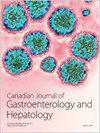糖皮质激素与炎症性肠病NAFLD的风险
IF 2.7
4区 医学
Q2 Medicine
引用次数: 9
摘要
每年,非酒精性脂肪肝(NAFLD)的发病率都在增加。NAFLD是一种慢性疾病。NAFLD最常见的原因之一是不适当的生活方式,其特点是缺乏或低体力活动,吃富含饱和脂肪和盐的高度加工食品,纤维含量低。此外,肠道微生物群紊乱和某些药物的使用可能使NAFLD易发。NAFLD是炎症性肠病(IBD)患者中越来越多被描述的疾病。最近的数据也表明,代谢综合征在这组患者中经常共存。某些药物组也会增加发生炎症、肝纤维化和肝硬化的风险。在NAFLD的发展中特别重要的是类固醇,它被用于治疗许多疾病,例如IBD。NAFLD是IBD患者最常见的肠外表现之一。然而,关于选定类型的类固醇的剂量和暴露时间可能导致NAFLD的发展,仍然没有足够的信息。有必要在这方面进行进一步的研究。因此,应持续监测IBD患者发生NAFLD的危险因素。本文章由计算机程序翻译,如有差异,请以英文原文为准。
Glucocorticosteroids and the Risk of NAFLD in Inflammatory Bowel Disease
Each year, the incidence of nonalcoholic fatty liver (NAFLD) disease increases. NAFLD is a chronic disease. One of the most common causes of NAFLD is an inadequate lifestyle, which is characterized by a lack or low physical activity and eating highly processed foods rich in saturated fat and salt and containing low amount of fiber. Moreover, disturbances in intestinal microbiome and the use of certain drugs may predispose to NAFLD. NAFLD is an increasingly described disease in patients with inflammatory bowel disease (IBD). Recent data also indicate a frequent coexistence of metabolic syndrome in this group of patients. Certain groups of drugs also increase the risk of developing inflammation, liver fibrosis, and cirrhosis. Particularly important in the development of NAFLD are steroids, which are used in the treatment of many diseases, for example, IBD. NAFLD is one of the most frequent parenteral manifestations of the disease in IBD patients. However, there is still insufficient information on what dose and exposure time of selected types of steroids may lead to the development of NAFLD. It is necessary to conduct further research in this direction. Therefore, patients with IBD should be constantly monitored for risk factors for the development of NAFLD.
求助全文
通过发布文献求助,成功后即可免费获取论文全文。
去求助
来源期刊

Canadian Journal of Gastroenterology and Hepatology
GASTROENTEROLOGY & HEPATOLOGY-
CiteScore
4.80
自引率
0.00%
发文量
0
审稿时长
37 weeks
期刊介绍:
Canadian Journal of Gastroenterology and Hepatology is a peer-reviewed, open access journal that publishes original research articles, review articles, and clinical studies in all areas of gastroenterology and liver disease - medicine and surgery.
The Canadian Journal of Gastroenterology and Hepatology is sponsored by the Canadian Association of Gastroenterology and the Canadian Association for the Study of the Liver.
 求助内容:
求助内容: 应助结果提醒方式:
应助结果提醒方式:


